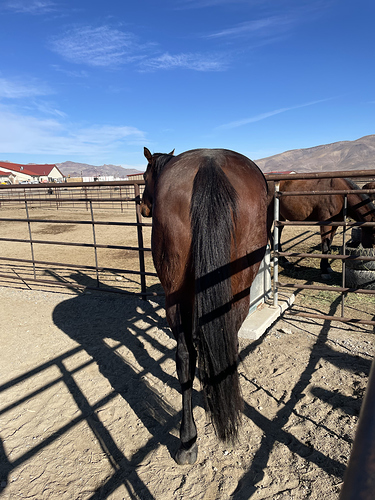Well…the hamstring is not just one muscle but a group of muscles. And the SI joint might be “stuck” but it isn’t “out” - as in out of joint.
If the horse has a lack of mobility on one side, it is not unlikely that would result in a muscle imbalance and what you’re seeing might be the junction between two muscles, but perhaps one is stronger and larger due to some kind of lack of balance. It could be caused by the stuck SI joint, or the SI joint might be stuck because of the muscle imbalance.
I am not a vet or an expert and can’t find a really good image - but maybe look here. http://www.healthequinetherapies.ca/resources/HET%20Muscle%20Information%20-%20Hamstring.pdf
The “dent” might be where the gluteus and bicep femoris come together? It’s hard to say from the images but a good massage therapist might be able to confirm.
I have a new human PT who is helping me proactively avoid injury for endurance sports. He is pretty fascinating and can identify each and every separate muscle in my leg and move them around and explain why one might be tighter than another. I had a small inflammation this week in an adductor muscle and he said that “most people would come in and say they hurt their hamstring,” but it was a specific adductor (there are 5 and I never realized). He believes that overall lack of mobility is the primary cause for a lot of injuries, not that injuries cause the lack of mobility. So I’m working to become more flexible and balance out some of my imbalances (things that get even worse by repetitive sports like running & cycling, for example.)
I think the chiro and massage are good starts but would also consider what exercise you are doing and making sure to balance it carefully - and/or actually do more on the “off” side than the strong side, so as to not make the imbalance greater. E.g. any time you are doing lateral work make sure you’re not doing more in the direction that is easier for him, but actually doing the opposite - more in the stiffer direction.
I would definitely ask if there are stretches or exercises that you can do and/or things to avoid. E.g. maybe doing more lateral work and less trot work would help.



 This beauty isn’t going anywhere, touch wood.
This beauty isn’t going anywhere, touch wood. You gotta love 'em.
You gotta love 'em.